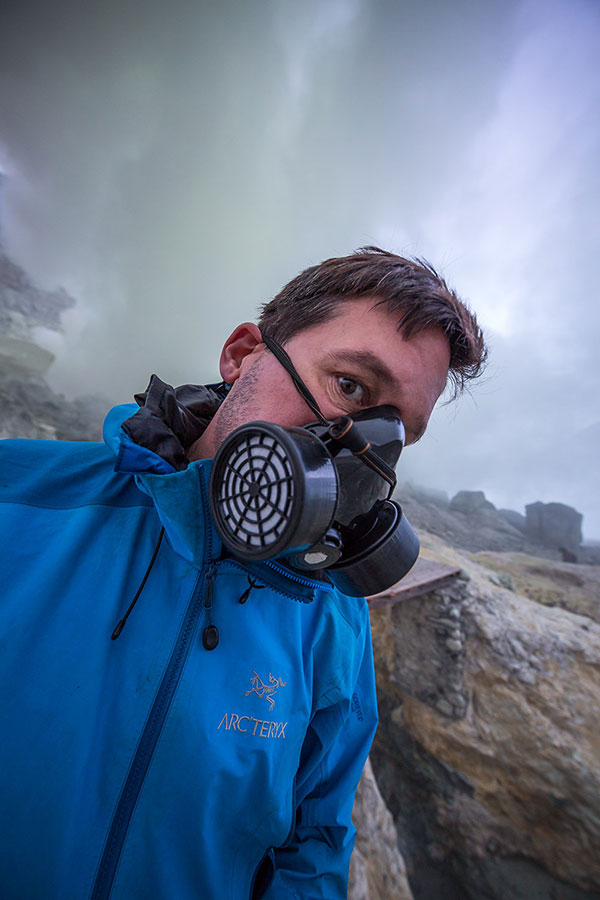Kilauea Volcano on the Big Island of Hawaii is one of the world’s most active volcanoes. In early 2016, an eruption sent lava flowing slowly towards the ocean, the first time in three years. Since August 2016, lava has been dribbling into the ocean, but after a collapse of the cliff at the ocean entry in December, the lava flow took on a dramatic change.
For the next few months, the lava was pouring out of a lava tube, plunging dozens of feet from a cliff straight into the ocean, looking like a molten waterfall. Dubbed the “firehose,” it quickly gained international recognition, and thousands of visitors flocked from all over the world to witness this stunning natural event.
In early March 2017, I received word from a local contact in Hawaii that surface lava activity had increased, so I hopped on the first plane I could to head there for photography. The firehose wasn’t my top priority, as I was more interested in working with surface flows where I could utilize a more personal approach. The firehose wasn’t easily viewed by land (because of heightened risk of a collapse, most of the cliff around the firehose was closed to the public), so I had to photograph it from a tour boat, which meant that my compositional options would be sorely limited. But considering the uniqueness of the firehose feature, I decided to spend a few mornings on the water, hoping to get something good.
So, twice in a row, I was up at 3:30am after late nights of long-distance trekking over the lava fields, just to be ready for a 4:30am boat departure. Each time, I wormed my way to the front of the boarding line to ensure a front-row seat with maximum visibility for photography. Then, after a bumpy thirty-minute ride on the boat in the pitch dark, we arrived at the firehose flow. What an amazing sight!
“I’ve seen a lot of incredible things in my decade of professional photography, but there’s nothing quite like watching a continuous flow of lava dropping forty or fifty feet into the water.”
Words simply can’t do it justice (nor, for that matter, can photographs). I’ve seen a lot of incredible things in my decade of professional photography, but there’s nothing quite like watching a continuous flow of lava dropping forty or fifty feet into the water. Unfortunately, I couldn’t just sit back and admire the beauty of the flow—I had work to do! Because I was shooting in extreme darkness, and I had to hand-hold my camera on the boat, I set my camera to shutter priority and Auto ISO. Since I was working with a wide angle of view (24mm), I could get sharp photos at 1/60 second despite the movement of the boat.
Both mornings, I took literally hundreds of photos, trying variations with different focal lengths ranging from short telephoto (200mm) when the boat was farther away from the flow, to ultra-wide (11mm) when the boat got in close. This was one of those “spray and pray” moments, but even though I might have seemed to a casual observer to be shooting wild, there was a method to my madness: I was looking for a coherent composition to emerge from the chaos of the constantly moving boat, the seething flow of lava, and the persistent explosions and shifting steam resulting from hot lava hitting cold water. I choose an exposure that retained detail in the brightest parts or the lava, letting the rest of the scene fade to black for a mysterious presentation.
The firehose has, unfortunately, proved to be short-lived, as recent reports indicate that it has stopped flowing. Always remember when photographing nature: nothing lasts forever, so when something cool is happening, get out there and photograph it before it goes away!
Related blog: Trip Report: Hawai’i Volcanoes National Park
About the author: World-renowned professional photographer and Tamron Image Master Ian Plant is a frequent contributor to a number of leading photo magazines (including Outdoor Photographer, Popular Photography, Landscape Photography, and others). You can see more of his work at www.ianplant.com.
Have something to add to the story? Leave a comment or email editor@outdoorphotographyguide.com.



Wonderful result from planning ahead, trying different things, and missing a lot of sleep. I'm fortunately going to get a front row seat to a night Launch from Vandenberg AFB on May 5th in California. I have two canon bodies 5D Mll 24-105 f4 and 70 D with the 70-200 f2.8. Can you point me in the right direction for tips on getting the most from this once in a lifetime opportunity. Tripod head is a wonderful Manfroto Gearhead. Great for landscapes not so much for tracking moving objects. Great work on your part as always. Thanks!
Ian, you have again outdone yourself. This one is a gem. The "centerpiece" is amazing and I totally love the foreground. Aesthetically and technically superb. Keep up the great work and thanks for sharing. David
The instant I opened this up I said WOW! I am travelling to Hawaii next year and can live in hope.
Outstanding photo!!!